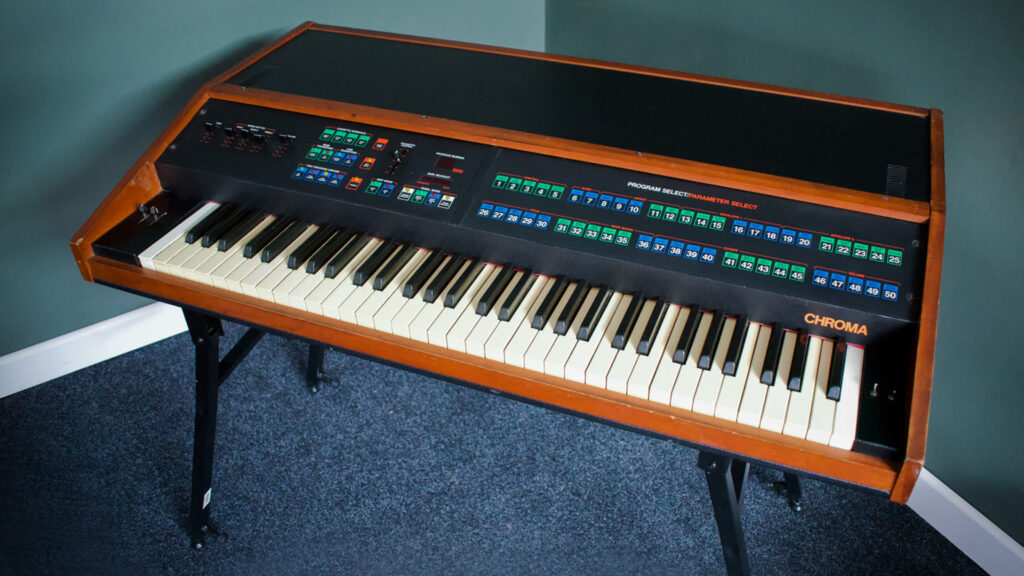
IN THIS WEEK’S EPISODE OF ‘ONCE UPON A TINE,’ WE LOOK AT THE RHODES CHROMA, A LEGEND AMONG VINTAGE SYNTHESISERS.
The 1980s heralded the start of a new era in music, with groundbreaking technology and innovative design taking centre stage. Rhodes was a forerunner in this revolution, fully embracing the changing landscape by introducing a revolutionary instrument: the Rhodes Chroma. Since its introduction in 1982, the Chroma has been a game changer for musicians, providing a versatile and powerful tool for exploring new sonic horizons. This achievement was made possible by the collaborative efforts of three visionary engineers – Philip Dodds, Paul DeRocco, and Tony Williams – who shared a passion for creating cutting-edge electronic musical instruments.

Rhodes Chroma development team: (front) Gil Madrid; (first row, left to right) Philip Dodds, Warren Ames, Don Ciarlone, Leo Keightley, John Hannon, and Tony Williams; (second row) Mark Smith, Robert Schmidt, Mary Lock, Sue Lord, Paul DeRocco; (third row) Robb Witt, Robert Hartford, Adam Hawkes, Mike Shea, Glen Goodrich. Source: Mary Lock
Dodds, DeRocco, and Williams previously worked together at ARP Instruments to create the ARP Chroma, the Chroma’s predecessor. During the 1970s, this company dominated the synthesiser market. When ARP Instruments ceased operations in 1981, the trio relocated to Rhodes, refining and elevating their design to new heights. This collaboration resulted in the Rhodes Chroma, a true masterpiece that combined the expertise of these talented engineers with Rhodes’ commitment to quality and innovation. This collaboration enabled the Chroma to become an influential instrument during the 1980s, shaping the soundscapes of countless artists and setting a new standard in electronic music.
THE MAGIC OF THE RHODES CHROMA
The Chroma is a synthesiser behemoth with unrivalled sound capabilities and a commanding physical presence weighing 71 lbs (32.2 kg). This instrument has a sturdy wooden casing, a 64-note velocity-sensitive keyboard with levered weighted wooden keys, and a front panel decorated with 71 membrane switches and two LED displays. The Chroma’s impressive characteristics propelled it to the forefront of the synthesiser market during its time.

Page two of the Rhodes Chroma product brochure. Source: Eric Mattei
The heart of this instrument is its 16-voice polyphony, which lays the groundwork for a wide range of sonic possibilities. Each voice has one VCO, a 12 dB/octave low/high-pass filter, two ADSR envelope generators, and an LFO. This sophisticated combination of components enables musicians to create a wide range of sounds, from lush pads and sharp leads to incredibly realistic emulations of acoustic instruments. The Chroma’s unrivalled flexibility and sound quality cemented its place as a groundbreaking instrument in electronic music.

Page three of the Rhodes Chroma product brochure. Source: Eric Mattei
One of the Chroma’s most innovative and distinguishing features is its unique programming method. Instead of traditional knobs and sliders, the Chroma employs a system of parameter access via membrane switches and a single assignable data slider. This novel approach resulted in a more compact and dependable design, though some users found navigating difficult. To address this issue and improve the user experience, Rhodes introduced the Chroma Music System, a software editor explicitly designed for use with the Apple II. The Chroma Music System takes a more intuitive approach to sound design and parameter control, making the process more accessible and user-friendly. This innovative addition to the Chroma ecosystem established its legacy as a revolutionary instrument in the world of synthesisers.
THE CHROMA CONNECTION
The Chroma’s external control capabilities set it apart from its competitors. This instrument was designed before MIDI and included a 25-pin D-sub connector computer interface, allowing users to connect it directly to an Apple II and use the Chroma Music System. This innovative addition enabled patch editing, storage, and even real-time performance control, making the Chroma an appealing choice for musicians and composers just getting started with computer-aided music production.

Page six of the Rhodes Chroma product brochure. Source: Eric Mattei
In addition to the Chroma, the Rhodes Chroma Expander was released as an auxiliary unit. The Chroma Expander has the same sound capabilities as the Chroma but without the keyboard, allowing musicians to expand their sonic palette without taking up valuable studio space. The Chroma Expander, like the Apple II, can be connected to the Chroma via the 25-pin D-sub connector, ensuring seamless integration between the two devices. Combining the Chroma and the Chroma Expander creates a powerful and adaptable platform for musicians to experiment with and create unique sounds.

Page seven of the Rhodes Chroma product brochure. Source: Eric Mattei
The Chroma and Chroma Expander quickly gained popularity among influential musicians such as Jethro Tull, Herbie Hancock, Joe Zawinul, and Oscar Peterson. These musicians praised the Chroma’s versatile sound capabilities and expressive keyboard, which allowed them to create a wide range of sonic textures. The Chroma’s innovative design and cutting-edge technology established it as a pivotal instrument in the evolution of computer-aided music production.
THE RHODES CHROMA LEGACY
The Chroma has earned a place in electronic music history for its distinct design and lush sonic potential. This instrument, which debuted during a period of significant change for the company, embodies Rhodes’ innovative spirit and commitment to expanding the horizons of musical expression. Although the Chroma was a commercial success, production lasted only two years, from 1982 to 1984, resulting in a limited run of around 3,000 units. This scarcity adds to the allure of this remarkable instrument, further cementing its status as a prized possession in electronic music.
To learn more about the Chroma, visit the Rhodes Super Site:
https://www.fenderrhodes.com/pianos/synth.html
